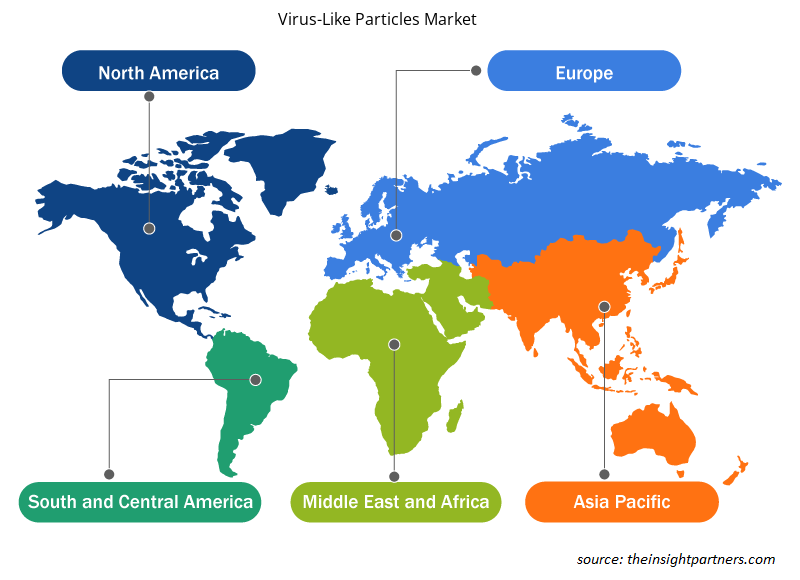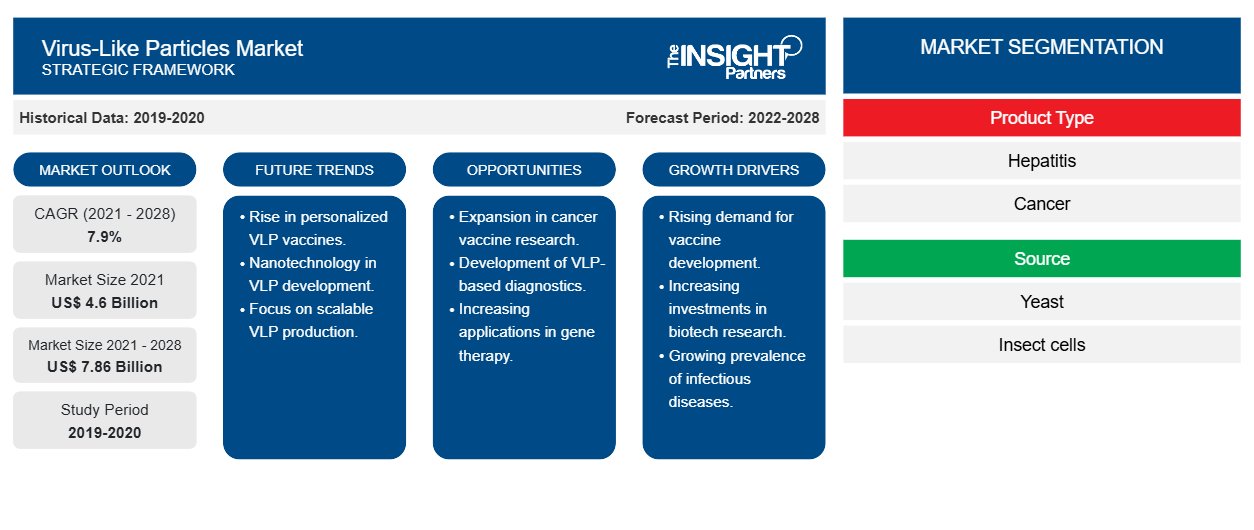Der Markt für virusähnliche Partikel (VLPs) soll von 4.601,84 Millionen US-Dollar im Jahr 2021 auf 7.858,82 Millionen US-Dollar im Jahr 2028 anwachsen; von 2021 bis 2028 wird mit einer durchschnittlichen jährlichen Wachstumsrate von 7,9 % gerechnet.
Die Kommerzialisierung virusähnlicher Partikel-basierter Impfstoffe gegen menschliche und tierische Viren, intensive Forschungs- und Entwicklungsaktivitäten zur Entwicklung virusähnlicher Partikel-basierter Virusimpfstoffe und die Entwicklung virusähnlicher Partikel als zuverlässige Immuntherapieplattform für allergische Erkrankungen sind die wichtigsten treibenden Faktoren für das allgemeine Marktwachstum. Technische Herausforderungen im Zusammenhang mit der Entwicklung, Reinigung und Lagerung von eVLPs hemmen jedoch das allgemeine Marktwachstum. Darüber hinaus schränken die mit der Herstellung virusähnlicher Partikel-Impfstoffe verbundenen Komplexitäten sowie die übermäßigen Kosten und der Zeitaufwand der Prozesse (wie die nachgelagerte Verarbeitung virusähnlicher Partikel-basierter Impfstoffe) das globale Marktwachstum weiter ein. Darüber hinaus befinden sich virusähnliche Partikel-basierte Therapeutika für aktuelle und neu auftretende Viruserkrankungen sowie Krebs noch in der Entwicklung, was lukrative Möglichkeiten für das allgemeine Marktwachstum bietet.
Nordamerika wird seine Vorherrschaft auf dem Markt für virusähnliche Partikel zwischen 2021 und 2028 voraussichtlich beibehalten. Die USA halten den größten Marktanteil in Nordamerika und dieser Trend wird sich im Prognosezeitraum voraussichtlich fortsetzen. Dies ist in erster Linie auf die allgemein beobachtete Anfälligkeit der Menschen für Virusinfektionen zurückzuführen, wie z. B. die durch verschiedene Varianten verursachte Virusgrippe. Darüber hinaus zwingen kontinuierliche F&E-Aktivitäten, die für die Herstellung von Lebendimpfstoffen erforderlich sind, biopharmazeutische Unternehmen dazu, sich für virusähnliche Partikel zu entscheiden, was das Marktwachstum weiter unterstützt.
Passen Sie diesen Bericht Ihren Anforderungen an
Sie erhalten kostenlos individuelle Anpassungen an jedem Bericht, einschließlich Teilen dieses Berichts oder einer Analyse auf Länderebene, eines Excel-Datenpakets sowie tolle Angebote und Rabatte für Start-ups und Universitäten.
- Holen Sie sich die wichtigsten Markttrends aus diesem Bericht.Dieses KOSTENLOSE Beispiel umfasst eine Datenanalyse von Markttrends bis hin zu Schätzungen und Prognosen.
Markteinblicke
Kommerzialisierte virusähnliche Partikel-basierte Impfstoffe treiben das Marktwachstum an
Einem Bericht von Frontiers Media SA zufolge wurde der erste Impfstoff auf Basis virusähnlicher Partikel zur Bekämpfung eines tödlichen Virus, Hepatitis B , entwickelt , und im Vergleich zu herkömmlichen Impfstoffen haben Impfstoffe auf Basis virusähnlicher Partikel vielversprechende Sicherheitsergebnisse erzielt. Der erste kommerziell erhältliche Impfstoff auf Basis virusähnlicher Partikel war gegen HBV. Auch die kommerziellen Anti-HBV-Impfstoffe, nämlich „Engerix“ von GlaxoSmithKline und „Recombivax HB“ von Merck & Co., wurden 1980 zugelassen, und sie alle bestanden aus virusähnlichen Partikeln. Der nächste kommerziell erhältliche Impfstoff auf Basis virusähnlicher Partikel war „Gardasil“, der 2006 zur Vorbeugung von Infektionen mit dem humanen Papillomavirus (HPV) zugelassen wurde. Darüber hinaus werden virusähnliche Partikel auch in der Veterinärmedizin verwendet. Der erste kommerziell erhältliche Veterinärimpfstoff auf Basis virusähnlicher Partikel erwies sich als wirksam gegen das porcine Circovirus Typ 2 (PCV2).
Die Rolle virusähnlicher Partikel bei der Entwicklung von Immuntherapieprodukten gegen allergische Erkrankungen stimuliert das allgemeine Marktwachstum zusätzlich. Virusähnliche Partikel werden zur Behandlung von allergischer Rhinitis, Asthma und Hausstaubmilbenreaktionen eingesetzt. Die oben genannten Faktoren treiben das Wachstum des gesamten Marktes für virusähnliche Partikel exponentiell voran. Impfstoffe mit virusähnlichen Partikeln haben eine schnelle Immunreaktion mit leichten Hautreaktionen als Nebenwirkung gezeigt.
Produkttypbasierte Einblicke
Basierend auf dem Produkttyp ist der Markt für virusähnliche Partikel in Hepatitis, Krebs/HPV und Morbus Gaucher segmentiert. Das Hepatitis-Segment dürfte zwischen 2021 und 2028 einen großen Marktanteil ausmachen. Der Bericht von Frontiers SA zeigt, dass das Hepatitis-C-Virus (HCV) 2 % der Weltbevölkerung infiziert und eine der Hauptursachen für Lebererkrankungen und Lebertransplantationen ist. Dieser medizinischen Bedrohung kann teilweise durch die Einführung neuer antiviraler Therapien begegnet werden . So reduziert beispielsweise ein Impfstoff mit einer Wirksamkeit von 50–80 %, der auf hochriskante intravenöse Drogenkonsumenten abzielt, die HCV-Inzidenz in der Bevölkerung drastisch. Virusähnliche Partikel stellen daher eine sichere und hoch immunogene Impfstoffverabreichungsplattform dar, die eine adaptive Immunantwort auslöst. Mehrere auf virusähnlichen Partikeln basierende Impfstoffe befinden sich derzeit in klinischen Tests; zugelassene VLP-Impfstoffe für HBV und HPV sind jedoch schon seit langem im Einsatz. Somit haben Impfstoffe auf Basis virusähnlicher Partikel ihre Wirksamkeit im Zusammenhang mit günstigen immunologischen Eigenschaften unter Beweis gestellt und zählen zu den vielversprechenden HCV-Impfstoffen.
Quellenbasierte Erkenntnisse
Basierend auf der Quelle ist der Markt für virusähnliche Partikel (VLPs) in Hefe, Insektenzellen, Pflanzen und andere unterteilt. Das Hefesegment hält einen beträchtlichen Marktanteil und wird voraussichtlich im Prognosezeitraum diesen Trend fortsetzen. Virusähnliche Partikel werden durch heterologe Expressionssysteme produziert, an denen Hefe oder Baculoviren sowie Pflanzen und Bakterien beteiligt sind. Die Sicherheit von Impfstoffen auf Basis virusähnlicher Partikel, die mithilfe von Hefeexpressionssystemen produziert werden, trägt zum Wachstum des Marktes für virusähnliche Partikel auf Hefebasis bei.
Anwendungsbasierte Erkenntnisse
Der Markt für virusähnliche Partikel wird nach Anwendung in Impfstoffe und Therapeutika unterteilt. Das Impfstoffsegment wird im Jahr 2021 einen beträchtlichen Marktanteil halten und seine marktbeherrschende Stellung voraussichtlich auch im Prognosezeitraum beibehalten. Impfungen gelten als eine der wirksamsten Methoden zur Bekämpfung von Krankheitserregern und zur Vorbeugung von Krankheiten sowohl bei Menschen als auch bei Tieren. Impfstoffe auf Basis virusähnlicher Partikel stellen aufgrund ihrer inhärenten immunogenen Eigenschaften und ihrer Sicherheit einen der attraktivsten Ansätze dar. Beispielsweise sind virusähnliche Partikel nichtinfektiöse, multimere Antigene mit einer Partikelstruktur, die sich zur Induktion einer sicheren und effizienten humoralen und zellulären Immunantwort eignen. Abgesehen davon haben Impfstoffe auf Basis virusähnlicher Partikel ihre Wirksamkeit im Veterinärbereich bewiesen. Virusähnliche Partikel bestehen nur aus einem oder mehreren Strukturproteinen ohne Vorhandensein von Genomen nativer Viren und ohne die Fähigkeit zur Selbstreplikation in Zellen. Da jedoch virusähnliche Partikel, die entweder monovalente oder multivalente Antigene enthalten, unter Einhaltung der Anforderungen an die serologische Überwachung hergestellt werden können, ist der Nutzen virusähnlicher Partikelimpfstoffe im Veterinärbereich vielversprechend. Ein Beispiel für die Verwendung virusähnlicher Partikelimpfstoffe im Rahmen von Impfstrategien zur Unterscheidung infizierter von geimpften Tieren (DIVA) gegen Tierkrankheiten.
Unternehmen, die auf dem Markt für virusähnliche Partikel (VLPs) tätig sind, verfolgen eine Produktinnovationsstrategie, um den sich weltweit entwickelnden Kundenanforderungen gerecht zu werden und gleichzeitig ihren Markennamen auf dem Weltmarkt zu behaupten.
Umfang des Marktberichts zu virusähnlichen Partikeln
Regionale Einblicke in den Markt für virusähnliche Partikel
Die regionalen Trends und Faktoren, die den Markt für virusähnliche Partikel während des gesamten Prognosezeitraums beeinflussen, wurden von den Analysten von Insight Partners ausführlich erläutert. In diesem Abschnitt werden auch Marktsegmente und Geografien für virusähnliche Partikel in Nordamerika, Europa, im asiatisch-pazifischen Raum, im Nahen Osten und Afrika sowie in Süd- und Mittelamerika erörtert.

- Holen Sie sich die regionalspezifischen Daten zum Markt für virusähnliche Partikel
Umfang des Marktberichts über virusähnliche Partikel
| Berichtsattribut | Details |
|---|---|
| Marktgröße im Jahr 2021 | 4,6 Milliarden US-Dollar |
| Marktgröße bis 2028 | 7,86 Milliarden US-Dollar |
| Globale CAGR (2021 - 2028) | 7,9 % |
| Historische Daten | 2019-2020 |
| Prognosezeitraum | 2022–2028 |
| Abgedeckte Segmente | Nach Produkttyp
|
| Abgedeckte Regionen und Länder | Nordamerika
|
| Marktführer und wichtige Unternehmensprofile |
|
Marktteilnehmerdichte: Der Einfluss auf die Geschäftsdynamik
Der Markt für virusähnliche Partikel wächst rasant, angetrieben durch die steigende Endverbrauchernachfrage aufgrund von Faktoren wie sich entwickelnden Verbraucherpräferenzen, technologischen Fortschritten und einem größeren Bewusstsein für die Vorteile des Produkts. Mit steigender Nachfrage erweitern Unternehmen ihr Angebot, entwickeln Innovationen, um die Bedürfnisse der Verbraucher zu erfüllen, und nutzen neue Trends, was das Marktwachstum weiter ankurbelt.
Die Marktteilnehmerdichte bezieht sich auf die Verteilung der Firmen oder Unternehmen, die in einem bestimmten Markt oder einer bestimmten Branche tätig sind. Sie gibt an, wie viele Wettbewerber (Marktteilnehmer) in einem bestimmten Marktraum im Verhältnis zu seiner Größe oder seinem gesamten Marktwert präsent sind.
Die wichtigsten auf dem Markt für virusähnliche Partikel tätigen Unternehmen sind:
- Merck & Co., Inc.
- GlaxoSmithKline plc.
- Pfizer Inc.
- Dynavax-Technologien
- Sanofi
Haftungsausschluss : Die oben aufgeführten Unternehmen sind nicht in einer bestimmten Reihenfolge aufgeführt.

- Überblick über die wichtigsten Akteure auf dem Markt für virusähnliche Partikel
Markt für virusähnliche Partikel (VLPs) – nach Produkttyp
- Hepatitis
- Krebs/HPV
- Morbus Gaucher
Markt für virusähnliche Partikel (VLPs) – nach Quelle
- Hefe
- Insektenzelle
- Anlage
- Sonstiges
Markt für virusähnliche Partikel (VLPs) – nach Anwendung
- Impfungen
- Therapeutika
Markt für virusähnliche Partikel (VLPs) – nach Geografie
- Nordamerika
- UNS
- Kanada
- Mexiko
- Europa
- Frankreich
- Deutschland
- Italien
- Vereinigtes Königreich
- Spanien
- Restliches Europa
- Asien-Pazifik (APAC)
- China
- Indien
- Südkorea
- Japan
- Australien
- Restlicher Asien-Pazifik-Raum
- Naher Osten und Afrika (MEA)
- Südafrika
- Saudi-Arabien
- Vereinigte Arabische Emirate
- Rest von MEA
- Süd- und Mittelamerika (SCAM)
- Brasilien
- Argentinien
- Rest von SCAM
Firmenprofile
- Merck & Co., Inc.
- GlaxoSmithKline plc.
- Pfizer Inc.
- Dynavax-Technologien
- Sanofi
- Wantai BioPharm
- Serum Institute of India Pvt. Ltd.
- BHARAT BIOTECH
- LG Chem
- VBI Vaccines Inc.
- Historische Analyse (2 Jahre), Basisjahr, Prognose (7 Jahre) mit CAGR
- PEST- und SWOT-Analyse
- Marktgröße Wert/Volumen – Global, Regional, Land
- Branchen- und Wettbewerbslandschaft
- Excel-Datensatz
Aktuelle Berichte
Verwandte Berichte
Erfahrungsberichte
Grund zum Kauf
- Fundierte Entscheidungsfindung
- Marktdynamik verstehen
- Wettbewerbsanalyse
- Kundeneinblicke
- Marktprognosen
- Risikominimierung
- Strategische Planung
- Investitionsbegründung
- Identifizierung neuer Märkte
- Verbesserung von Marketingstrategien
- Steigerung der Betriebseffizienz
- Anpassung an regulatorische Trends





















 Kostenlose Probe anfordern für - Markt für virusähnliche Partikel
Kostenlose Probe anfordern für - Markt für virusähnliche Partikel